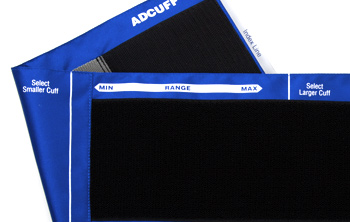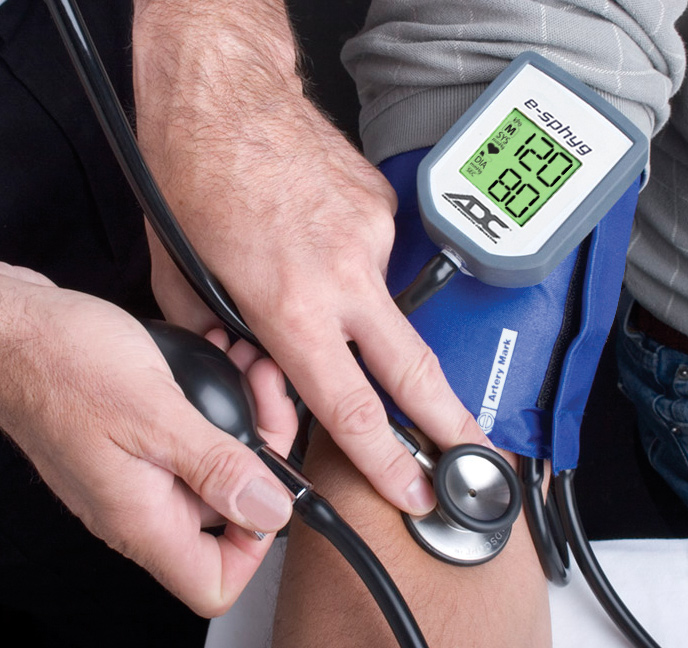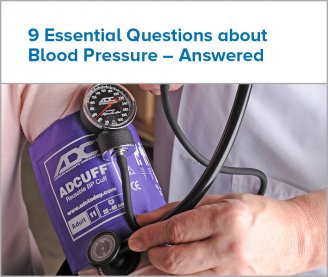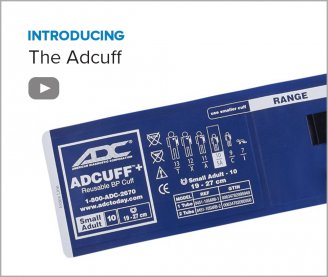- Products
- New Products
- Featured Products
- Color and Print Themes
- Blood Pressure Measurement
- NIBP / Vital Sign Monitors
- Digital Aneroid Sphygmomanometers
- Palm Aneroid Sphygmomanometers
- Pocket Aneroid Sphygmomanometers
- Pro's Combo Sphygmomanometers
- Multicuff Sphygmomanometers
- Clock Aneroid Sphygmomanometers
- Mercury Sphygmomanometers
- Home Blood Pressure Measurement
- Adcuff +
- Gauges
- Bulb & Valves
- Disposable Cuffs
- Reusable Cuffs & Bladders
- Sphygmomanometer Accessories
- Sphygmomanometer Parts
- Caseware
- CPR / Airway
- EENT
- Instruments & Accessories
- Laryngoscopes
- Penlights
- Pulse Oximeters
- Stethoscopes
- Thermometry
- Vital Signs Monitors
- Solutions
- About ADC
- Learning Center
- Support
- Blog
- Contact
How to Take Blood Pressure
Patient Positioning:
The patient should sit or lie comfortably. The arm should be fully supported on a flat surface at heart level. (If the arm’s position varies, or is not level with the heart, measurement values obtained will not be consistent with the patient’s true blood pressure). When seated, the patient should have his or her back and arm supported, and legs should be uncrossed. The patient should relax comfortably for five minutes prior to the measurement being taken, and should refrain from talking or moving during measurement. The observer should view the manometer in a direct line to avoid “parallax error.”
Application of the Cuff:

Range markings are part of the ADCUFF™ system. Using an inappropriately sized cuff can affect blood pressure readings.
ADCUFF™ nylon cuffs are specially designed to promote the precise and accurate determination of blood pressure. Index and range markings ensure use of the correct cuff size. The artery mark indicates proper cuff positioning.
Place the cuff over the bare upper arm with the artery mark positioned directly over the brachial artery. The bottom edge of the cuff should be positioned approximately one inch (2-3 cm) above the antecubital fold. Wrap the end of the cuff not containing the bladder around the arm snugly and smoothly and engage adhesive strips. To verify a correct fit, check that the Index Line falls between the two Range Lines.
Cuff Inflation:
Close the ADFLOW™ valve by turning thumbscrew clockwise. Palpate the radial artery while inflating the cuff. Be sure to inflate cuff quickly by squeezing bulb rapidly. Inflate cuff 20-30 mmHg above the point at which the radial pulse disappears.
Positioning the Stethoscope:

The correct positioning of the cuff, as shown by the Artery Mark, and stethoscope for optimal measurement.
Position the chestpiece in the antecubital space below the cuff, distal to the brachium. Do not place chestpiece underneath the cuff, as this impedes accurate measurement. Use the bell side of a combination stethoscope for clearest detection of the low pitched Korotkoff (pulse) sounds.
Deflate the Cuff:
Open the valve to deflate the cuff gradually at a rate of 2-3 mmHg per second. Record the onset of Korotkoff sounds as the systolic pressure, and the disappearance of these sounds as diastolic pressure. (Some healthcare professionals recommend recording diastolic 1 and diastolic 2. Diastolic one occurs at phase 4).
NOTE: It is recommended that K4 be used in children aged 3 to 12, and K5 should be used for pregnant female patients unless sounds are audible with the cuff deflated, in which case K4 should be used. K5 should be used for all other adult patients.
After measurement is completed, open valve fully to release any remaining air in the cuff and remove the cuff. Do not leave the cuff on the patient for an extended period of time.
Factors Affecting Measurements:
When taking blood pressure, it is vital that all of the steps involved in the process are properly observed. Small variations in technique can cause large variances in measurements, even on the same patient. The chart below shows some common issues that could affect readings:

- 1. Adiyaman Ahmet, Tosun Nevin, Elving LammyD, Deinum Jaap, Lenders JacquesWM, Thien Theo. The effect of crossing legs on blood pressure. Blood Press Monit June 2007; 12:3: 189-193.
- 2. Campbell NormanRC, McKay DonaldW. Accurate blood pressure measurement: Why does it matter? CMAJ 1999; 161(3): 277-278.
- 3. Cushman WilliamC, Cooper KarenM, Horne RichardA, Meydrech EdwardF. Effect of back support and stethoscope head on seated blood pressure determinations. Am J Hypertens 1990; 3: 240-241.
- 4. Fonseca-Reyes Salvador, Garcia de Alba-Garcia Javier, Parra-Carrillo JoseZ, Paczka-Zapata Jose Antonio. Effect of standard cuff on blood pressure readings in patients with obese arms. How frequent are arms of a ‘large circumference’? Blood Press Monit 2003 8:3: 101-106.
- 5. Foster-Fitzpatrick Lucille, Ortiz Anna, Sibilano Helena, Marcantonio Richard, Braun LynneT. The effects of crossed leg on blood pressure measurement. Nursing Research Mar/Apr 1999; 48:2: 105-108.
- 6. Geddes LA, Whistler SJ. The error in indirect blood pressure measurement with the incorrect size cuff. Amer Heart J July 1978; 96:1: 4-8.
- 7. Gomez-Marin O, Prineas RJ, Rastam L. Cuff bladder width and blood pressure measurement in children adolescents. J of Hypertens Oct 1992; 10:10: 1235-1241.
- 8. Iyriboz Y, Hearon CM, Edwards K. Agreement between large and small cuffs in sphygmomanometry: A quantitative assessment. J of Clin Monitoring Mar 1994; 10:2:127-133.
- 9. Keele-Smith Rebecca, Price-Daniel CeCilia. Effects of crossing legs on blood pressure measurement (Research Data). Virginia Henderson Internat Nurs Lib Aug 2007.
- 10. Lockwood Craig, Conroy-Hiller Tiffany, Page Tamara. Vital signs. JBI Reports 2004;2: 207-230.
- 11. Lynch JamesJ, Long JackM, Thomas SueAnn, Malinow KennethL, Katcher AaronHonori. The effects of talking on the blood pressure of hypertensive and normotensive individuals. Psychosomatic Medicine Feb 1981; 43:1: 25-33.
- 12. Manning DennisM, Kuchirka Carolee, Kaminski Jill. Miscuffing: inappropriate blood pressure cuff application. Diag Methods Hypertens 1983; 68:4: 763-766.
- 13. Marx GertieF, Orkin LouisR. Overdistention of the urinary bladder during and after anaesthesia. Can Anaes Soc J Sep 1966; 13:5: 500-504.
- 14. Netea RT, Lenders JWM, Smits P, Thien T. Arm position is important for blood pressure measurement. J Hum Hypertens Feb 1999; 13:2: 105-109.
- 15. Nicholas WC, Watson RL, Barnes TY, Goodinow C, Russel E. Does blood pressure cuff size make a difference in blood pressure readings? J Mississippi Med Assoc Feb 1985; 26:2.
- 16. O’Brien Eoin, Asmar Roland, Beilin Lawrie, Imai Yutaka, Mallion Jean-Michel, Mancia Giuseppe, Mengden Thomas, Myers Martin, Padfield Paul, Palatini Paolo, Parati Gianfranco, Pickering Thomas, Redon Josep, Staessen Jan, Stergiou George, Verdecchia Paolo. European Society of Hypertension recommendations for conventional, ambulatory and home blood pressure measurement. J Hypertens 2003; 21: 821-848.
- 17. Peters GrantL, Binder SaraK, Campbell NormRC. The effect of crossing legs on blood pressure: a randomized single-blind cross-over study. Blood Pressure Monitoring 1999; 4:2: 97-101.
- 18. Pickering ThomasG, Hall JohnE, Appel LawrenceJ, Falkner BonitaE, Graves John, Hill MarthaN, Jones DanielW, Kurtz Theodore, Sheps SheldonG, Roccella EdwardJ. Recommendations for blood pressure measurement in humans and experimental animals: Part 1:Blood pressure measurement in humans: A statement for professionals from the Subcommittee of Professional and Public Education of the American Heart Association Council on High Blood Pressure Research . Hypertens 2005; 45: 142-161.
- 19. Rastam I, Prineas RJ, Gomez-Marin O. Ration of cuff width/arm circumference as a determinant of arterial blood pressure measurements in adults.
- 20. Roubsanthisuk Weranuj, Wongsurin Unticha, Saravich Surachai, Buranakitjaroen Peera. Blood pressure determination by traditionally trained personnel is less reliable and tends to underestimate the severity of moderate to severe hypertension. Blood Press Monit 2007; 12: 61-68.
Additional Resources:
While hands-on training is the best method for learning the specifics of blood pressure measurement, online training and the use of audio sound files can be an invaluable learning tool. Below is an external link that may assist you in learning more about various conditions and sounds you may encounter when performing blood pressure measurement.
Practical Clinical Skills:http://www.practicalclinicalskills.com/taking-blood-pressure.aspx



